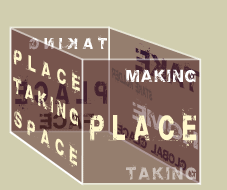In his book the French ethnologist Marc Aug? employs a concept of space constituted mostly of physical elements. Non-places are free of history and identity, quantifiable in surfaces, distances, and volumes. "But non-places are the real measure of our time; one that could be quantified…” (1). In Aug?’s understanding, non-places are transitory spaces such as roads, cable and radio networks, and shopping malls. The space of non-places are corridor-like, and movement within them is one of overcoming distances between various (socially determined) places. The distinction between places and non-places is predicated on a supposed opposition between place and space. In the notion of anthropological place Aug? includes “the possibility of the journeys made in it, the discourses uttered in it, and the language characterizing it” (2). Accordingly, place is a space shaped by culture and discourse whose identity, relation, and history distinguishes it from the non-place. Here Aug? equates place and space, though most often he uses space as a synonym for non-place. “If a space can be defined as relational, historical, and concerned with identity,” he argues, “then a space that cannot be defined as relational, historical, and concerned with identity will be a non-place” (3). More explicitly: “The distinction between places and non-places derives from the opposition between place and space” (4).
Today–15 years after the French original of first appeared–one has to ask whether the non-places Aug? describes have since become cultural spaces. For the geographer Yi-Fu Tuan, space and place denote human memory and experience most of all. In his “Place is security and space is freedom: we are attached to the one and long to the other” (5).
Quotes:
(1-4) Marc Aug?: Orte und Nicht-Orte, Vor?berlegungen zu einer Ethnologie der Einsamkeit, Fischer, Frankfurt 1994
(5) Yi-Fu Fuan: Space and place, the perspective of experience, University of Minnesota Press, 1977

